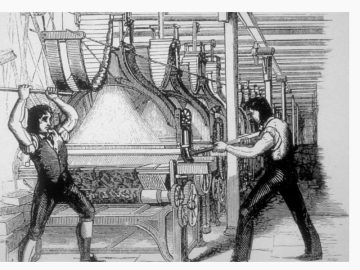Listen
NEW! Listen to article
Sign in or sign up to access this audio feature! No worries … it’s FREE!
In today’s rapidly evolving digital landscape, marketers face an unprecedented challenge: how to harness artificial intelligence (AI) effectively while maintaining the human touch that’s crucial for building lasting business relationships.
As AI becomes ubiquitous in marketing tools and strategies, a new paradigm is emerging—one that doesn’t pit humans against machines, but instead harnesses the power of both.
Welcome to the era of the “Human-Ready Marketing Organization.”
The AI Integration Paradox in Marketing
As marketing departments rush to integrate AI into their operations, a paradox emerges: Although AI adoption is essential for staying competitive, it’s no longer a differentiator in itself; every marketing team is using AI in some capacity, whether it’s for data analysis, content creation, or campaign optimization.
The true competitive advantage now lies in how effectively a marketing organization can blend AI capabilities with uniquely human skills.
And that synergy is not just about coexistence. It’s about creating a symbiotic relationship where AI and human marketers enhance each other’s strengths.
In a world increasingly shaped by algorithms, the marketing teams that prioritize human connection while deploying AI capabilities will be the ones that truly excel.
The Rising Value of the Human Touch in Marketing
Interestingly, as we automate more marketing processes, the human element becomes rarer and, consequently, more valuable. That trend is particularly evident in marketing, where relationships and trust play a crucial role in decision-making.
Consider the enduring appeal of personalized, high-touch marketing approaches. Though AI can generate personalized content at scale, it’s the human-crafted, emotionally resonant messages that often cut through the noise and truly connect with decision-makers.
That principle extends beyond content—to all aspects of marketing.
For instance, although AI can efficiently handle lead scoring and initial outreach, it’s often the human follow-up that closes deals. Salesforce and HubSpot are among the companies that have recognized that fact, integrating AI tools for efficiency while maintaining a strong emphasis on human-led relationship-building.
Defining the Human-Ready Marketing Organization
A Human-Ready Marketing Organization is one that has mastered the art of integrating AI with human capabilities in a way that maximizes value creation across the entire marketing funnel.
It’s about designing your marketing processes and roles to foster a strong connection between AI and human strengths while mitigating their respective weaknesses.
The key lies in ensuring that human marketers don’t impede the efficiency and scalability of AI, while AI enhances rather than diminishes the human touch that builds trust and loyalty in relationships.
That balance is delicate and requires a strategic approach.
The Value and Innovation Principle in Marketing
To achieve that balance, we can apply what we’ll call the “Value and Innovation Principle” to marketing.
This principle suggests focusing human efforts on marketing activities that drive core value, spark innovation, or require emotional intelligence—even if AI has the capacity to handle those tasks. All other activities can be delegated to AI.
This approach ensures that human creativity, critical thinking, and social abilities are applied where they can create the most significant impact in marketing campaigns, while AI handles tasks that benefit from its speed, accuracy, and scalability.
The Human-AI Partnership in Marketing Action
Let’s explore how this principle plays out across various marketing functions.
1. Content Strategy and Creation
Although AI excels at analyzing vast amounts of data to identify content trends and even generate basic content, humans are crucial for developing overarching content strategies and creating emotionally resonant, thought-leadership pieces.
The most effective content marketing approaches combine AI-driven insights with human creativity and industry expertise.
For example, AI tools can analyze engagement data across various platforms to suggest topics and formats that are likely to perform well. Human content strategists can then take those insights and develop a comprehensive content plan that aligns with the brand’s voice, values, and long-term business goals.
In content creation, AI can assist with tasks like research and basic drafting, but human writers and editors are essential for injecting the nuance, creativity, and emotional depth that truly engages audiences.
2. Campaign Planning and Execution
AI can process historical campaign data and market trends to suggest optimal campaign structures, timing, and channel mix. However, human marketers are essential for understanding the broader business context, interpreting AI-generated insights, and making strategic decisions that align with overall business objectives.
For instance, an AI system might recommend a particular type of campaign based on past performance data. But a human marketer, understanding the nuances of the current market situation, competitive landscape, and specific client needs, can refine and adapt those recommendations to create a truly impactful campaign strategy.
3. Customer Segmentation and Personalization
AI excels at analyzing customer data to identify patterns and create detailed segments. It can also automate personalization at scale. However, human marketers bring invaluable insights to understanding the nuances of different buyer personas, their pain points, and decision-making processes.
A Human-Ready Marketing Organization might use AI to create initial customer segments and generate personalized content variations. Human marketers would then review and refine those segments, ensuring they truly reflect the complexities of their audience.
They would also oversee the personalization strategy, ensuring that automated personalization doesn’t come across as tone-deaf or overly robotic, especially in high-stakes communications.
4. Lead Nurturing and Customer Relationship Management
AI can efficiently handle lead scoring, email automation, and basic customer interactions, but human touch remains crucial in relationship-building.
AI can provide valuable insights into customer behavior and preferences, but human marketers are essential for interpreting those insights and using them to build meaningful, long-term relationships.
For example, AI might flag a lead as being highly engaged based on that lead’s interaction with your content. A human marketer can then reach out personally, armed with AI-provided insights, to have a meaningful conversation that addresses the prospect’s specific needs and concerns.
Human-AI collaboration ensures that lead nurturing is both efficient and genuinely relationship-focused.
5. Analytics and Performance Optimization
AI is unparalleled in its ability to process vast amounts of marketing data and identify patterns and trends. However, human marketers are crucial for asking the right questions, interpreting results in context, and making strategic decisions based on those insights.
A Human-Ready Marketing Organization might use AI to continually monitor campaign performance across all channels, automatically adjusting parameters (e.g., ad bids or email send times) for optimal performance.
Human marketers would then review AI-generated reports, connecting the dots between different data points, understanding the “why” behind the numbers, and making strategic decisions about resource allocation and long-term marketing direction.
Implementing the Human-Ready Marketing Model
Transforming your marketing team into a Human-Ready Marketing Organization requires a strategic approach. Here are key steps to consider:
- Assess your current marketing tech stack. Evaluate your existing marketing tools and identify areas where AI can enhance efficiency without compromising the human touch. Look for opportunities to integrate AI into repetitive tasks, such as data analysis, basic content creation, and campaign optimization.
- Redefine marketing roles. Redesign job roles to focus on tasks that require human creativity, emotional intelligence, and critical thinking. This step may involve upskilling your team in various areas, such as AI interpretation, strategic thinking, and advanced relationship-building techniques.
- Invest in AI education for marketers. Ensure your team understands AI capabilities and limitations in the context of marketing. That knowledge will help them work more effectively alongside AI systems and make better decisions about when to rely on AI and when to apply human judgment.
- Foster a collaborative culture. Encourage a mindset that views AI as a powerful tool rather than a threat to marketing jobs. Promote collaboration among AI specialists, data analysts, and traditional marketers to create more powerful, integrated marketing strategies.
- Prioritize ethical considerations. Develop clear guidelines for AI use in marketing that prioritize transparency, fairness, and privacy. Human oversight is crucial to ensuring ethical AI deployment, especially in contexts where trust is paramount.
- Ongoing Learning and Adaptation. The AI landscape in marketing is evolving rapidly. Foster a culture of continual learning and be prepared to adapt your strategies as new technologies emerge. Encourage your team to stay updated on the latest AI marketing tools and techniques.
The Future of Marketing: A Three-Tier Approach to Decision-Making
As we look to the future of marketing in a Human-Ready Organization, it’s helpful to consider a three-category framework for AI-human collaboration in marketing decision-making:
- Decisions supported by AI. Humans analyze and make decisions using AI-generated data and insights. This approach is ideal for high-level strategic decisions. For instance, CMOs might review AI-generated market analysis and campaign performance data, but ultimately rely on their experience and understanding of the business landscape to set the overall marketing direction.
- Decisions elevated by AI. AI analyzes and suggests options, but humans review those options and make the final call. This approach is particularly useful for tactical decisions that benefit from a human touch. Content marketers, for example, might use AI to generate content ideas and outlines, but then apply their creativity and brand understanding to craft the final piece.
- Decisions automated by AI. These are typically routine, low-risk decisions that AI can handle independently without human involvement. For example, AI might automatically adjust email send times based on individual recipient behavior, or optimize ad bids in real-time based on performance data.
This framework ensures that we employ AI’s capabilities in marketing while retaining essential human oversight where it matters most.
Challenges and Considerations
Although the potential benefits of becoming a Human-Ready Marketing Organization are significant, there are challenges to consider:
- Skills gap. Many marketers may lack the technical skills to work effectively with AI tools. Investing in AI training and potentially hiring for new hybrid roles (e.g., “AI Marketing Strategist”) may be necessary.
- Data quality and integration. AI systems are only as good as the data they’re fed. Ensuring clean, integrated data across all marketing systems is crucial but can be challenging.
- Ethical concerns. As AI takes on more decision-making roles in marketing, ethical considerations become increasingly important. Various issues, such as data privacy, transparency in AI-driven personalization, and potential biases in AI systems, need to be carefully managed.
- Maintaining brand voice. Though AI can generate content at scale, ensuring consistency in brand voice and messaging can be challenging. Human oversight remains crucial.
- Measuring success. Developing new metrics to measure the success of human-AI collaboration in marketing may be necessary, as traditional KPIs might not capture the full value created.
The Path Forward for Marketers
As we navigate the future of marketing, the key to success lies in embracing the synergy between AI and human capabilities. This isn’t about marketers competing with AI, nor is it about resisting technological advancement. Instead, it’s about creating a collaborative environment where each enhances the other’s strengths.
The marketing teams that thrive in the coming years will be those that master this delicate balance, creating marketing strategies that are not just technologically advanced, but truly human-centric. By focusing on developing frameworks and practices that foster this AI-human collaboration, we can create a future of marketing that is not only more efficient and data-driven but also more creative, empathetic, and ultimately, more effective in building lasting business relationships.
In a world increasingly driven by algorithms, the Human-Ready Marketing Organization stands out not just for its technological prowess, but for its ability to leverage the best of both worlds—the efficiency and scalability of AI, and the creativity, empathy, and strategic thinking of human marketers. This synergy is the key to creating lasting value and maintaining a competitive edge in the digital age of marketing.
As marketing leaders, our challenge—and our opportunity—is to cultivate this synergy, ensuring that our organizations remain not just AI-ready, but truly Human-Ready. In doing so, we can unlock unprecedented levels of marketing effectiveness, innovation, and customer engagement, while also creating more fulfilling and meaningful work environments for our marketing teams. The future of marketing belongs to the Human-Ready Marketing Organization. Are you ready to lead the way?
More Resources on AI and Humans in Marketing
When AI Is Too Much: How to Balance Human and AI Marketing
Your AI Needs a Human Copyeditor
Personalization vs. Intrusion: How a Mix of Artificial and Human Intelligence Can Create Balance
ChatGPT Has Turned 1: What Have We Learned From AI’s Breakout Year?





